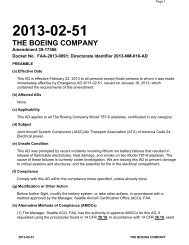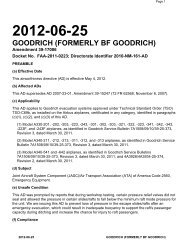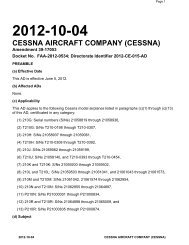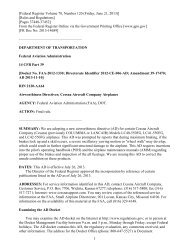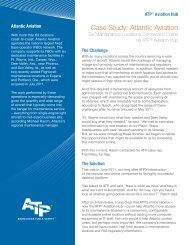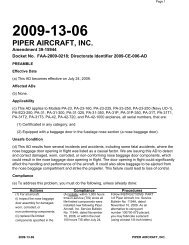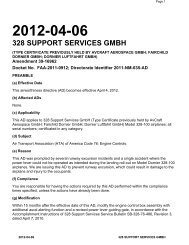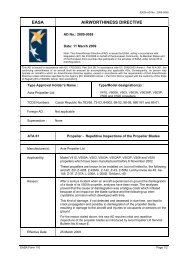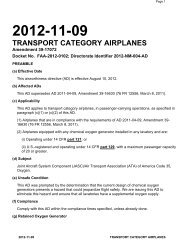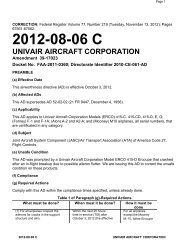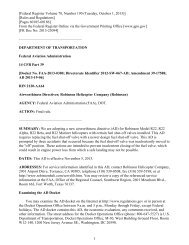2013-16-22 - Tdata IApproach airworthiness directives,aviation ...
2013-16-22 - Tdata IApproach airworthiness directives,aviation ...
2013-16-22 - Tdata IApproach airworthiness directives,aviation ...
Create successful ePaper yourself
Turn your PDF publications into a flip-book with our unique Google optimized e-Paper software.
[Federal Register Volume 78, Number <strong>16</strong>4 (Friday, August 23, <strong>2013</strong>)]<br />
[Rules and Regulations]<br />
[Pages 524<strong>16</strong>-52419]<br />
From the Federal Register Online via the Government Printing Office [www.gpo.gov]<br />
[FR Doc No: <strong>2013</strong>-19463]<br />
––––––––––––––––––––––––––––––––––<br />
DEPARTMENT OF TRANSPORTATION<br />
Federal Aviation Administration<br />
14 CFR Part 39<br />
[Docket No. FAA-<strong>2013</strong>-0092; Directorate Identifier 2012-NM-067-AD; Amendment 39-17560;<br />
AD <strong>2013</strong>-<strong>16</strong>-<strong>22</strong>]<br />
RIN 2120-AA64<br />
Airworthiness Directives; Embraer S.A. Airplanes<br />
AGENCY: Federal Aviation Administration (FAA), Department of Transportation (DOT).<br />
ACTION: Final rule.<br />
––––––––––––––––––––––––––––––––––<br />
SUMMARY: We are adopting a new <strong>airworthiness</strong> directive (AD) for certain Embraer S.A. Model<br />
ERJ 170 and ERJ 190 airplanes. This AD was prompted by reports of chafing between the auxiliary<br />
power unit (APU) electronic starter controller (ESC) power cables and the airplane tail cone firewall.<br />
This AD requires a detailed inspection for damage to the insulation and inner conductors of the APU<br />
ESC power cables, installing a new grommet support in the tail cone firewall, and corrective actions<br />
if necessary. We are issuing this AD to detect and correct damage to the APU ESC power cable<br />
harness, which if not corrected, could result in reduced structural integrity of the fuselage and<br />
empennage in the event of fire penetration through the firewall.<br />
DATES: This AD becomes effective September 27, <strong>2013</strong>.<br />
The Director of the Federal Register approved the incorporation by reference of certain<br />
publications listed in this AD as of September 27, <strong>2013</strong>.<br />
ADDRESSES: You may examine the AD docket on the Internet at http://www.regulations.gov or in<br />
person at the U.S. Department of Transportation, Docket Operations, M-30, West Building Ground<br />
Floor, Room W12-140, 1200 New Jersey Avenue SE., Washington, DC.<br />
FOR FURTHER INFORMATION CONTACT: Cindy Ashforth, Aerospace Engineer,<br />
International Branch, ANM-1<strong>16</strong>, Transport Airplane Directorate, FAA, <strong>16</strong>01 Lind Avenue SW.,<br />
Renton, WA 98057-3356; telephone (425) <strong>22</strong>7-2768; fax (425) <strong>22</strong>7-1149.<br />
1
SUPPLEMENTARY INFORMATION:<br />
Discussion<br />
We issued a notice of proposed rulemaking (NPRM) to amend 14 CFR part 39 to include an AD<br />
that would apply to the specified products. That NPRM was published in the Federal Register on<br />
February <strong>22</strong>, <strong>2013</strong> (78 FR 1<strong>22</strong>56). That NPRM proposed to correct an unsafe condition for the<br />
specified products. The Agência Nacional de Aviação Civil (ANAC), which is the <strong>airworthiness</strong><br />
authority for Brazil, has issued Brazilian Airworthiness Directives 2012-03-03 and 2012-03-04, both<br />
effective April 13, 2012 (referred to after this as the Mandatory Continuing Airworthiness<br />
Information, or ''the MCAI''), to correct an unsafe condition for the specified products. The MCAI<br />
states:<br />
It has been found the occurrences of chafing between the Auxiliary Power Unit (APU)<br />
Electronic Starter Controller (ESC) power cables (harness W205) and the airplane tail<br />
cone firewall due to the grommet installed in the tail cone firewall moves out of its<br />
place. This condition, if not corrected, may result in reduced structural integrity of the<br />
fuselage and empennage in an event of fire penetration through the firewall. * * *<br />
The required actions include a detailed inspection for damage to the harness insulation and inner<br />
conductors of the APU ESC power cables, installing a new grommet support in the tail cone firewall,<br />
and corrective actions if necessary. Corrective actions include repairing the harness W205 insulation<br />
or replacing the harness W205 of the APU ESC power cables with a new harness. You may obtain<br />
further information by examining the MCAI in the AD docket.<br />
Comments<br />
We gave the public the opportunity to participate in developing this AD. We have considered the<br />
comments received.<br />
Request To Add Credit for Actions Accomplished in Accordance With Previous Service<br />
Information<br />
Embraer S.A. requested that we revise the NPRM (78 FR 1<strong>22</strong>56, February <strong>22</strong>, <strong>2013</strong>) to allow<br />
credit for work done prior to the effective date of the proposed AD using Embraer Service Bulletin<br />
170-53-0093, dated February 28, 2011; Embraer Service Bulletin 190-53-0054, dated February 28,<br />
2011; or Embraer Service Bulletin 190LIN-53-0059, dated March 29, 2011; which are now all at<br />
Revision 01, dated March <strong>16</strong>, 2012. Embraer notes that the instructions contained in the original issue<br />
of the service information combined with the instructions Embraer has provided to operators on a<br />
case-by-case basis are equivalent.<br />
We disagree with the commenter's request because the FAA has no familiarity with the<br />
individual repair or replacement instructions provided by Embraer to each operator and cannot<br />
evaluate them for equivalence to the instructions in the required service information. The MCAI also<br />
does not allow credit for work performed using previous versions of the service information.<br />
Operators may apply for an alternative method of compliance (AMOC) for these actions in<br />
accordance with the provisions of paragraph (i)(1) of this AD. We have not changed the AD in this<br />
regard.<br />
Explanation of Additional Changes Made to This AD<br />
2
We have revised the wording of paragraph (g) of this AD, which previously required a detailed<br />
visual inspection instead of a detailed inspection. We have also added paragraph (h) of this AD,<br />
which includes the definition of a detailed inspection.<br />
Conclusion<br />
We reviewed the available data, including the comment received, and determined that air safety<br />
and the public interest require adopting this AD as proposed–except for minor editorial changes. We<br />
have determined that these minor changes:<br />
• Are consistent with the intent that was proposed in the NPRM (78 FR 1<strong>22</strong>56, February <strong>22</strong>,<br />
<strong>2013</strong>) for correcting the unsafe condition; and<br />
• Do not add any additional burden upon the public than was already proposed in the NPRM<br />
(78 FR 1<strong>22</strong>56, February <strong>22</strong>, <strong>2013</strong>).<br />
Costs of Compliance<br />
We estimate that this AD will affect 253 products of U.S. registry. We also estimate that it will<br />
take about 15 work-hours per product to comply with the basic requirements of this AD. The average<br />
labor rate is $85 per work-hour. Required parts will cost about $0 per product. Where the service<br />
information lists required parts costs that are covered under warranty, we have assumed that there<br />
will be no charge for these parts. As we do not control warranty coverage for affected parties, some<br />
parties may incur costs higher than estimated here. Based on these figures, we estimate the cost of<br />
this AD to the U.S. operators to be $3<strong>22</strong>,575, or $1,275 per product.<br />
Authority for This Rulemaking<br />
Title 49 of the United States Code specifies the FAA's authority to issue rules on <strong>aviation</strong> safety.<br />
Subtitle I, section 106, describes the authority of the FAA Administrator. ''Subtitle VII: Aviation<br />
Programs,'' describes in more detail the scope of the Agency's authority.<br />
We are issuing this rulemaking under the authority described in ''Subtitle VII, Part A, Subpart III,<br />
Section 44701: General requirements.'' Under that section, Congress charges the FAA with promoting<br />
safe flight of civil aircraft in air commerce by prescribing regulations for practices, methods, and<br />
procedures the Administrator finds necessary for safety in air commerce. This regulation is within the<br />
scope of that authority because it addresses an unsafe condition that is likely to exist or develop on<br />
products identified in this rulemaking action.<br />
Regulatory Findings<br />
We determined that this AD will not have federalism implications under Executive Order 13132.<br />
This AD will not have a substantial direct effect on the States, on the relationship between the<br />
national government and the States, or on the distribution of power and responsibilities among the<br />
various levels of government.<br />
For the reasons discussed above, I certify that this AD:<br />
1. Is not a ''significant regulatory action'' under Executive Order 12866;<br />
2. Is not a ''significant rule'' under the DOT Regulatory Policies and Procedures (44 FR 11034,<br />
February 26, 1979);<br />
3. Will not affect intrastate <strong>aviation</strong> in Alaska; and<br />
4. Will not have a significant economic impact, positive or negative, on a substantial number of<br />
small entities under the criteria of the Regulatory Flexibility Act.<br />
We prepared a regulatory evaluation of the estimated costs to comply with this AD and placed it<br />
in the AD docket.<br />
3
Examining the AD Docket<br />
You may examine the AD docket on the Internet at http://www.regulations.gov; or in person at<br />
the Docket Operations office between 9 a.m. and 5 p.m., Monday through Friday, except Federal<br />
holidays. The AD docket contains this AD, the regulatory evaluation, any comments received, and<br />
other information. The street address for the Docket Operations office (telephone (800) 647-5527) is<br />
in the ADDRESSES section.<br />
List of Subjects in 14 CFR Part 39<br />
Air transportation, Aircraft, Aviation safety, Incorporation by reference, Safety.<br />
Adoption of the Amendment<br />
Accordingly, under the authority delegated to me by the Administrator, the FAA amends 14 CFR<br />
part 39 as follows:<br />
PART 39–AIRWORTHINESS DIRECTIVES<br />
1. The authority citation for part 39 continues to read as follows:<br />
Authority: 49 U.S.C. 106(g), 40113, 44701.<br />
§ 39.13 [Amended]<br />
2. The FAA amends § 39.13 by adding the following new AD:<br />
4
FAA<br />
Aviation Safety<br />
AIRWORTHINESS DIRECTIVE<br />
www.faa.gov/aircraft/safety/alerts/<br />
www.gpoaccess.gov/fr/advanced.html<br />
<strong>2013</strong>-<strong>16</strong>-<strong>22</strong> Embraer S.A: Amendment 39-17560. Docket No. FAA-<strong>2013</strong>-0092; Directorate<br />
Identifier 2012-NM-067-AD.<br />
(a) Effective Date<br />
This <strong>airworthiness</strong> directive (AD) becomes effective September 27, <strong>2013</strong>.<br />
(b) Affected ADs<br />
None.<br />
(c) Applicability<br />
This AD applies to the airplane models identified in paragraphs (c)(1) and (c)(2) of this AD.<br />
(1) Embraer S.A. Model ERJ 170-100 LR, -100 STD, -100 SE., and -100 SU airplanes; and<br />
Model ERJ 170-200 LR, -200 SU, and -200 STD airplanes; certificated in any category; as identified<br />
in Embraer Service Bulletin 170-53-0093, Revision 01, dated March <strong>16</strong>, 2012.<br />
(2) Embraer S.A. Model ERJ 190-100 STD, -100 LR, -100 ECJ, and -100 IGW airplanes; and<br />
Model ERJ 190-200 STD, -200 LR, and -200 IGW airplanes; certificated in any category; as<br />
identified in Embraer Service Bulletin 190-53-0054, Revision 01, dated March <strong>16</strong>, 2012; and<br />
Embraer Service Bulletin 190LIN-53-0059, Revision 01, dated March <strong>16</strong>, 2012.<br />
(d) Subject<br />
Air Transport Association (ATA) of America Code 53, Fuselage.<br />
(e) Reason<br />
This AD was prompted by reports of chafing between the auxiliary power unit (APU) electronic<br />
starter controller (ESC) power cables and the airplane tail cone firewall. We are issuing this AD to<br />
detect and correct damage to the APU ESC power cable harness, which could result in reduced<br />
structural integrity of the fuselage and empennage in the event of fire penetration through the<br />
firewall.<br />
(f) Compliance<br />
You are responsible for having the actions required by this AD performed within the compliance<br />
times specified, unless the actions have already been done.<br />
(g) Detailed Inspection, Installation, and Corrective Actions<br />
Within 3,000 flight hours or 18 months after the effective date of this AD, whichever occurs<br />
first: Do a detailed inspection for damage to the insulation and inner conductors of the APU ESC<br />
power cables (harness W205), in accordance with the Accomplishment Instructions of Embraer<br />
Service Bulletin 170-53-0093, Revision 01, dated March <strong>16</strong>, 2012 (for Model ERJ 170 airplanes);<br />
5
Embraer Service Bulletin 190-53-0054, Revision 01, dated March <strong>16</strong>, 2012 (for Model ERJ 190<br />
airplanes except for Model ERJ 190-100 ECJ airplanes); and Embraer Service Bulletin 190LIN-53-<br />
0059, Revision 01, dated March <strong>16</strong>, 2012 (for Model ERJ 190-100 ECJ airplanes).<br />
(1) If no damage is found, before further flight, install a new grommet support having part<br />
number (P/N) 191-217<strong>16</strong>-003 in the tail cone firewall, in accordance with the Accomplishment<br />
Instructions of Embraer Service Bulletin 170-53-0093, Revision 01, dated March <strong>16</strong>, 2012 (for<br />
Model ERJ 170 airplanes); Embraer Service Bulletin 190-53-0054, Revision 01, dated March <strong>16</strong>,<br />
2012 (for Model ERJ 190 airplanes except for Model ERJ 190-100 ECJ airplanes); or Embraer<br />
Service Bulletin 190LIN-53-0059, Revision 01, dated March <strong>16</strong>, 2012 (for Model ERJ 190-100 ECJ<br />
airplanes).<br />
(2) If any damage is found during any inspection required in paragraph (g) of this AD that affects<br />
only the insulation of harness W205 of the APU ESC power cables: Before further flight, repair the<br />
insulation and install a new grommet support having P/N 191-217<strong>16</strong>-003 in the tail cone firewall, in<br />
accordance with the Accomplishment Instructions of Embraer Service Bulletin 170-53-0093,<br />
Revision 01, dated March <strong>16</strong>, 2012 (for Model ERJ 170 airplanes); Embraer Service Bulletin 190-53-<br />
0054, Revision 01, dated March <strong>16</strong>, 2012 (for Model ERJ 190 airplanes except for Model ERJ 190-<br />
100 ECJ airplanes); or Embraer Service Bulletin 190LIN-53-0059, Revision 01, dated March <strong>16</strong>,<br />
2012 (for Model ERJ 190-100 ECJ airplanes).<br />
(3) If any damage is found during any inspection required in paragraph (g) of this AD that affects<br />
the insulation of harness W205 of the APU ESC power cables and the inner conductors: Before<br />
further flight, replace the harness with a new harness and install a new grommet support having P/N<br />
191-217<strong>16</strong>-003 in the tail cone firewall, in accordance with the Accomplishment Instructions of<br />
Embraer Service Bulletin 170-53-0093, Revision 01, dated March <strong>16</strong>, 2012 (for Model ERJ 170<br />
airplanes); Embraer Service Bulletin 190-53-0054, Revision 01, dated March <strong>16</strong>, 2012 (for Model<br />
ERJ 190 airplanes except for Model ERJ 190-100 ECJ airplanes); or Embraer Service Bulletin<br />
190LIN-53-0059, Revision 01, dated March <strong>16</strong>, 2012 (for Model ERJ 190-100 ECJ airplanes).<br />
(h) Definition of Detailed Inspection<br />
For the purpose of this AD, a detailed inspection is: An intensive examination of a specific item,<br />
installation or assembly to detect damage, failure or irregularity. Available lighting is normally<br />
supplemented with a direct source of good lighting at an intensity deemed appropriate. Inspection<br />
aids such as mirrors, magnifying lenses, etc., may be necessary. Surface cleaning and elaborate<br />
access procedures may be required.<br />
(i) Other FAA AD Provisions<br />
The following provisions also apply to this AD:<br />
(1) Alternative Methods of Compliance (AMOCs): The Manager, International Branch, ANM-<br />
1<strong>16</strong>, Transport Airplane Directorate, FAA, has the authority to approve AMOCs for this AD, if<br />
requested using the procedures found in 14 CFR 39.19. In accordance with 14 CFR 39.19, send your<br />
request to your principal inspector or local Flight Standards District Office, as appropriate. If sending<br />
information directly to the International Branch, send it to ATTN: Cindy Ashforth, Aerospace<br />
Engineer, International Branch, ANM-1<strong>16</strong>, Transport Airplane Directorate, FAA, <strong>16</strong>01 Lind Avenue<br />
SW., Renton, WA 98057-3356; telephone: (425) <strong>22</strong>7-2768; fax (425) <strong>22</strong>7-1149. Information may be<br />
emailed to: 9-ANM-1<strong>16</strong>-AMOC-REQUESTS@faa.gov. Before using any approved AMOC, notify<br />
your appropriate principal inspector, or lacking a principal inspector, the manager of the local flight<br />
standards district office/certificate holding district office. The AMOC approval letter must<br />
specifically reference this AD.<br />
(2) Airworthy Product: For any requirement in this AD to obtain corrective actions from a<br />
manufacturer or other source, use these actions if they are FAA-approved. Corrective actions are<br />
6
considered FAA-approved if they are approved by the State of Design Authority (or their delegated<br />
agent). You are required to assure the product is airworthy before it is returned to service.<br />
(j) Related Information<br />
Refer to Mandatory Continuing Airworthiness Information (MCAI) Brazilian Airworthiness<br />
Directives 2012-03-03 and 2012-03-04, both effective April 13, 2012, for related information. This<br />
MCAI may be found in the AD docket on the Internet at http://www.regulations.gov.<br />
(k) Material Incorporated by Reference<br />
(1) The Director of the Federal Register approved the incorporation by reference (IBR) of the<br />
service information listed in this paragraph under 5 U.S.C. 552(a) and 1 CFR part 51.<br />
(2) You must use this service information as applicable to do the actions required by this AD,<br />
unless the AD specifies otherwise.<br />
(i) Embraer Service Bulletin 170-53-0093, Revision 01, dated March <strong>16</strong>, 2012.<br />
(ii) Embraer Service Bulletin 190-53-0054, Revision 01, dated March <strong>16</strong>, 2012.<br />
(iii) Embraer Service Bulletin 190LIN-53-0059, Revision 01, dated March <strong>16</strong>, 2012.<br />
(3) For service information identified in this AD, contact Embraer S.A., Technical Publications<br />
Section (PC 060), Av. Brigadeiro Faria Lima, 2170–Putim–1<strong>22</strong>27-901 São Jose dos Campos–SP–<br />
BRASIL; telephone +55 12 3927-5852 or +55 12 3309-0732; fax +55 12 3927-7546; email<br />
distrib@embraer.com.br; Internet http://www.flyembraer.com.<br />
(4) You may review copies of the service information at the FAA, Transport Airplane<br />
Directorate, <strong>16</strong>01 Lind Avenue SW., Renton, WA. For information on the availability of this material<br />
at the FAA, call 425-<strong>22</strong>7-1<strong>22</strong>1.<br />
(5) You may view this service information that is incorporated by reference at the National<br />
Archives and Records Administration (NARA). For information on the availability of this material at<br />
NARA, call 202-741-6030, or go to: http://www.archives.gov/federal-register/cfr/ibr-locations.html.<br />
Issued in Renton, Washington, on August 2, <strong>2013</strong>.<br />
Jeffrey E. Duven,<br />
Acting Manager, Transport Airplane Directorate,<br />
Aircraft Certification Service.<br />
7



